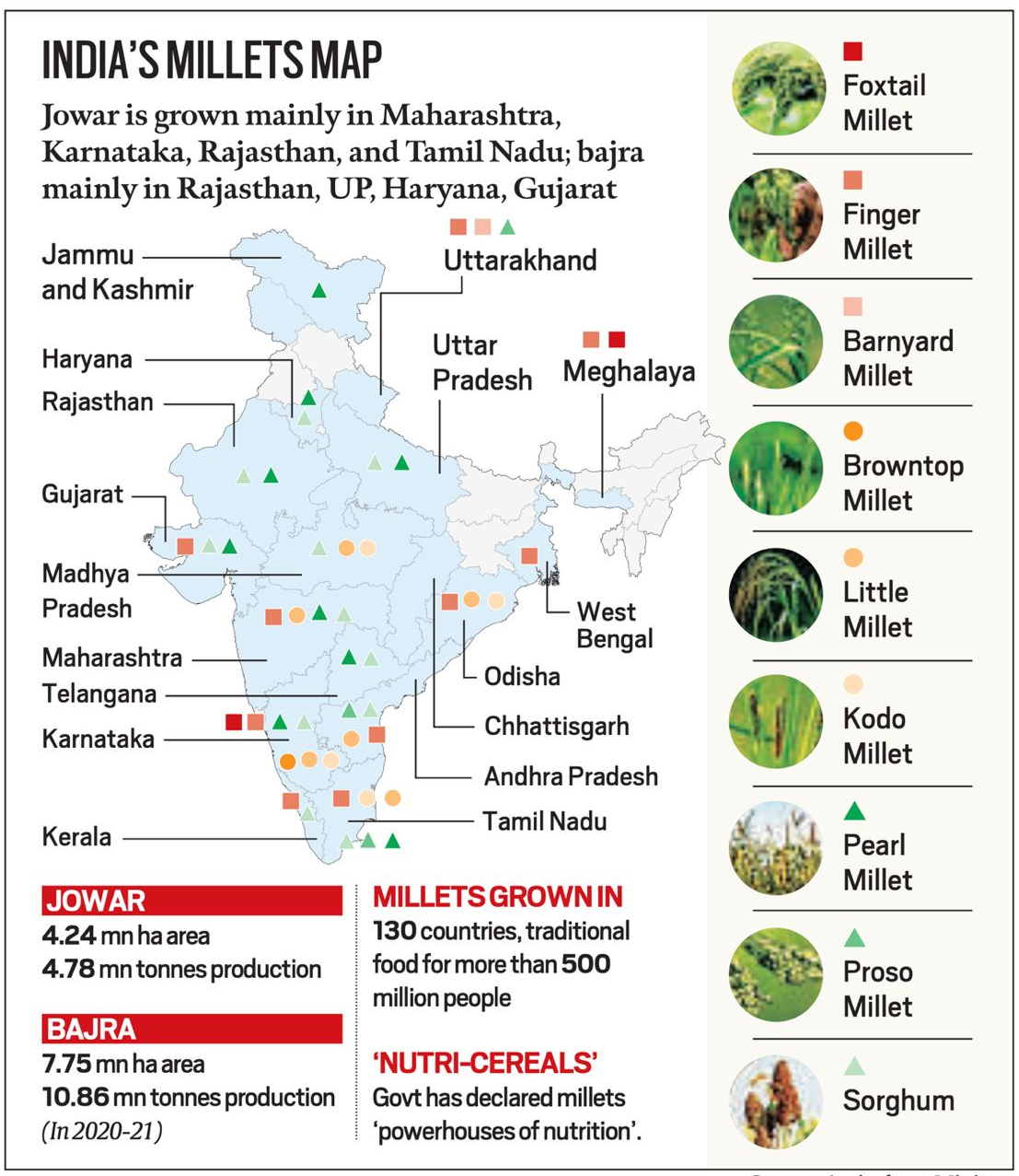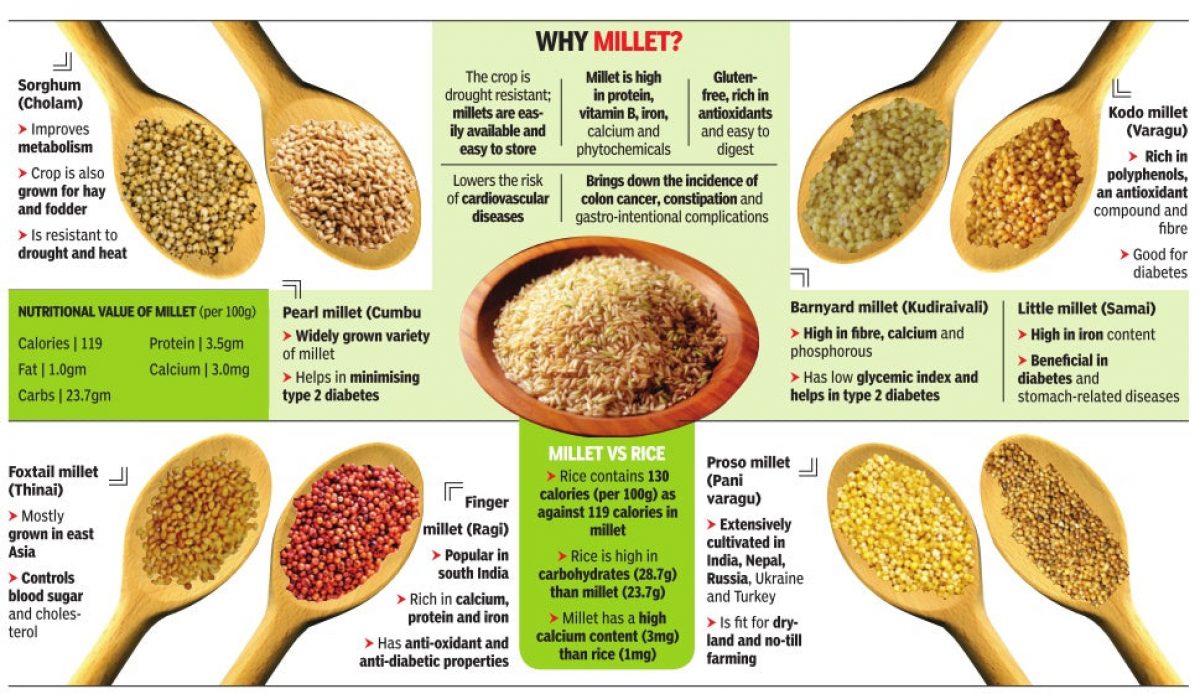- Home
- Prelims
- Mains
- Current Affairs
- Study Materials
- Test Series
 EDITORIALS & ARTICLES
EDITORIALS & ARTICLES
2023: the Year of Millets
- 2023 has been declared as the “International Year of Millets” by the United Nations, after a proposal from India in 2019. On 20 December 2022, to raise awareness on millets and prepare for 2023, Prime Minister Narendra Modi, along with fellow parliamentarians across party lines, enjoyed a sumptuous lunch where millets were front and centre.
- The menu for the feast, as shared by ANI, included Bajra soup, Ragi dosa and roti, Foxtail millet Bisibelebath and Joladha roti among other items. For dessert, Ragi halwa, Jowar halwa and Bajra kheer were three of the offerings.
What are millets, India’s indigenous foodgrains?
- The term millet is used to describe small-grained cereals like sorghum (jowar), pearl millet (bajra), foxtail millet (kangni/ Italian millet), little millet (kutki), kodo millet, finger millet (ragi/ mandua), proso millet (cheena/ common millet), barnyard millet (sawa/ sanwa/ jhangora), and brown top millet (korale).
- Millets were among the first crops to be domesticated. There is evidence for consumption of millets in the Indus-Sarasvati civilisation (3,300 to 1300 BCE). Several varieties that are now grown around the world were first cultivated in India. West Africa, China, and Japan are also home to indigenous varieties of the crop.
- Millets are now grown in more than 130 countries, and are the traditional food for more than half a billion people in Asia and Africa. Globally, sorghum (jowar) is the biggest millet crop. The major producers of jowar are the United States, China, Australia, India, Argentina, Nigeria, and Sudan. Bajra is another major millet crop; India and some African countries are major producers.
- In India, millets are mainly a kharif crop. During 2018-19, three millet crops — bajra (3.67%), jowar (2.13%), and ragi (0.48%) — accounted for about 7 per cent of the gross cropped area in the country, Agriculture Ministry data show.

Where are millets produced (and consumed)?
- Jowar is mainly grown in Maharashtra, Karnataka, Rajasthan, Tamil Nadu, Andhra Pradesh, Uttar Pradesh, Telangana, and Madhya Pradesh. In 2020-21, the area under jowar stood at 4.24 million hectares, while production was 4.78 million tonnes. Maharashtra accounted for the largest area (1.94 mn ha) and production (1.76 million tonnes) of jowar during 2020-21.
- Bajra is mainly grown in Rajasthan, Uttar Pradesh, Haryana, Gujarat, Madhya Pradesh, Maharashtra and Karnataka. Of the total 7.75 mn ha under bajra in 2020-21, the highest (4.32 mn ha) was in Rajasthan. The state also produced the most bajra in the country (4.53 million tonnes of the total 10.86 million tonnes) in 2020-21.
- The consumption of millets was reported mainly from these states: Gujarat (jowar and bajra), Karnataka (jowar and ragi), Maharashtra (jowar and bajra), Rajasthan (bajra), and Uttarakhand (ragi).
Why are millets “good”?
- Millets are eco-friendly crops – they require much less water than rice and wheat, and can be grown in rainfed areas without additional irrigation. According to a 2019 study, “wheat and rice have the lowest green water footprints but the highest blue water footprints, while millets were exactly opposite.” Green water footprint refers to water from precipitation whereas blue water refers to water from land sources. Thus, millets require the least amount of irrigation to be grown.
- They are also highly nutritious. On 10 April 2018, the Agriculture Ministry declared certain varieties of millets as “Nutri Cereals” for the purposes of production, consumption, and trade. These include Jowar, bajra, ragi/ mandua, the minor millets — kangani/ kakun, cheena, kodo, sawa/ sanwa/ jhangora, and kutki — and the two pseudo millets, buckwheat (kuttu) and amaranth (chaulai).
- The Story of Millets published by the Karnataka State Department of Agriculture in association with ICAR-Indian Institute of Millets Research, Hyderabad, says, “Millets contain 7-12% protein, 2-5% fat, 65-75% carbohydrates and 15-20% dietary fibre… Small millets are more nutritious compared to fine cereals. They contain higher protein, fat and fibre content.”
 2023: the Year of Millets
2023: the Year of Millets
- On 3 March 2021, the United Nations General Assembly (UNGA) adopted a resolution to declare 2023 as the International Year of Millets. The proposal, moved by India, was supported by 72 countries. Several events and activities, including conferences and field activities, and the issuing of stamps and coins, are expected as part of the celebrations aimed at spreading awareness about millets, inspiring stakeholders to improve production and quality, and attracting investments.









 Latest News
Latest News General Studies
General Studies